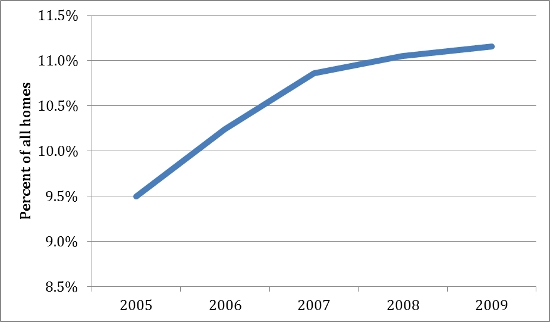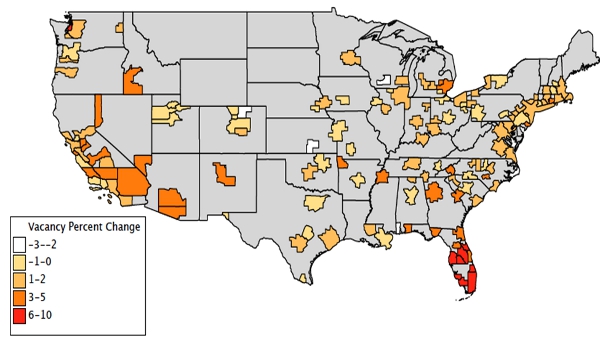
 One of the more visible aspects of the Great Recession and its associated housing crisis has been the rise in the number of vacant homes across the U.S. But has this increase in the number of empty houses had an effect on other social problems such as crime? In new research that uses Census data on home vacancies, and FBI data on crime, Roderick W. Jones and William Alex Pridemore find that when a city’s home vacancy rate increased by one percent, its burglary rate rose by 1.21 percent, but that its robbery rate remained unchanged. They also find that the local unemployment rate is important to this relationship, with higher rates associated with diminished crime rates.
One of the more visible aspects of the Great Recession and its associated housing crisis has been the rise in the number of vacant homes across the U.S. But has this increase in the number of empty houses had an effect on other social problems such as crime? In new research that uses Census data on home vacancies, and FBI data on crime, Roderick W. Jones and William Alex Pridemore find that when a city’s home vacancy rate increased by one percent, its burglary rate rose by 1.21 percent, but that its robbery rate remained unchanged. They also find that the local unemployment rate is important to this relationship, with higher rates associated with diminished crime rates.
Between 2005 and 2009 the United States experienced an historic economic recession that was caused largely by catalysts within the housing industry. During this housing crisis, the home vacancy rate rose by nearly 20 percent, increasing from 9.5 to 11.2 percent, as shown in Figure 1. Scholars throughout the United States began to wonder if some of the characteristics of the housing crisis were having an impact on other social problems like crime, violence, and suicide. In recent research, we find that increasing home vacancies are positively and significantly associated with burglary rates but not with robbery rates.
Figure 1 – Change in Home Vacancy rates in U.S. cities 2005 – 2009

Home vacancy presents significant problems to those cities that have seen it occur in large amounts. Vacant homes affect neighborhood social organization by disrupting important social networks through changes to the characteristics of the population and the place. These properties may also provide criminal opportunities if the vacant home becomes a target for burglary and theft. Vacant homes may also provide a location for illicit behavior like drug dealing, drug use, prostitution, vandalism, and vagrancy.
Research shows that large numbers of vacant properties can negatively affect investment, redevelopment, property values, and rental values. These negative economic circumstances hinder an area’s ability to sustain physical infrastructure, which further increases mobility and disorder and may ultimately increase the probability for crime. Further, home vacancy presents significant economic problems to cities because vacant homes fail to generate tax dollars while adding additional costs because local officials are required to maintain properties and monitor illegal behavior. In concert, these factors mean that cities experiencing increases in home vacancy are being structurally conditioned for higher crime rates. Figure 2 shows an example of a vacant home.
Figure 2 – Vacant Home in California

While broad in scope, the U.S. housing crisis was not evenly distributed across cities in the United States. States like Florida, California, and Michigan were hit particularly hard. This variation in the housing crisis means that social problems like crime may also have been impacted differentially across cities throughout the U.S. Figure 3 shows the substantial variation in percent change in vacancy rates in large cities throughout the country. Although other studies have examined the general association between foreclosure and crime and reached inconsistent conclusions, our study was among the first to gauge the effects of home vacancy on crime in multiple cities during one of the most detrimental housing crises in history.
Figure 3 – Percent Change in Home Vacancy in Large U.S. Cities between 2005 and 2009

With such increases in home vacancy throughout the country we sought to answer the following question: Was the variation in changes in home vacancy rates associated with changes in violent (e.g., robbery) and property crime (e.g., burglary) in U.S. metropolitan areas? In our research, we answered these questions by analyzing U.S. Census Bureau and Federal Bureau of Investigation (FBI) data between 2005 and 2009 in a sample of 142 large metropolitan statistical areas (MSAs). The U.S. Census data included measures of home vacancy and demographic and social measures that act as important controls. The FBI data included measures of burglary and robbery per 100,000 residents. Our study was longitudinal in nature, which allowed us to examine the effects of the change in home vacancy rates on the change in crime rates as opposed to examining only rates at a single point in time. It is important to measure change during the housing crisis because the rise in home vacancy was not immediate. Rather, the vacancy rate increased over a number of years as more households were negatively affected by the deepening economic recession.
To examine the relationship between home vacancy and burglary and robbery rates we used two separate methods the take advantage of our longitudinal data. Our results showed that increasing home vacancy was positively and significantly associated with burglary rates but not with robbery rates. We found that, on average, when a city’s vacancy rate increased by one percent its burglary rate increased by 1.21 percent. Further, our results showed that the impact of home vacancy on burglary was partially moderated by levels of unemployment. That is, the effect of home vacancy on the burglary rate was dependent upon the city’s unemployment rate. In cities with high rates of unemployment the effect of home vacancy on crime was diminished. While this may seem counterintuitive, there is empirical evidence suggesting high unemployment reduces certain types of crime because more people are at home and thus able to more effectively protect themselves and their homes.
The findings from our study add to the growing body of research examining the effects of the housing crisis on crime rates. Some of these findings are inconsistent because they examine the general association between foreclosure and crime. However, when taken together with other recent studies of the housing crisis and crime, our results suggest that when the more specific measure of vacancy rates increases one likely outcome is an increase in burglary rates. In the future, administrators in American cities should be prepared to counter this effect when home vacancy rises.
This article is based on the paper ‘A Longitudinal Study of the Impact of Home Vacancy on Robbery and Burglary Rates During the U.S. Housing Crisis, 2005-2009′, in Crime & Delinquency.
Please read our comments policy before commenting.
Note: This article gives the views of the author, and not the position of USApp– American Politics and Policy, nor of the London School of Economics.
Shortened URL for this post: http://bit.ly/1q7hdSP
_________________________________
 Roderick W. Jones – Indiana University
Roderick W. Jones – Indiana University
Roderick W. Jones is a doctoral candidate in the Department of Criminal Justice at Indiana University. His research interests are in the areas of spatial dynamics of urban crime rates, the role of housing policy and planning on crime rates, social structure and crime, violence, and suicide, and theoretical integration and elaboration. Roderick’s recent research appears in Crime & Delinquency, Social Science Quarterly, and Cityscape.
 William Alex Pridemore – Georgia State University
William Alex Pridemore – Georgia State University
William Alex Pridemore is Distinguished University Professor in the Department of Criminal Justice & Criminology at Georgia State University, where he is also senior researcher in the Evidence-Based Policy Cluster. His main criminological research interests include social structure and violence, alcohol and violence, and cross-national homicide rates. He also carries out research on alcohol epidemiology, the Russian mortality crisis, the sociology of health and illness, and domestic terrorism. His articles have appeared in the leading journals of several disciplines, including criminology, sociology, public health, and substance abuse.



